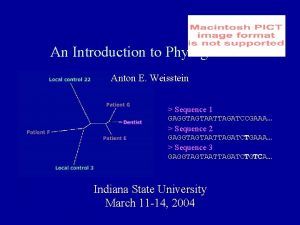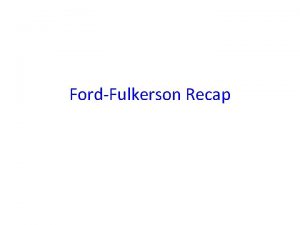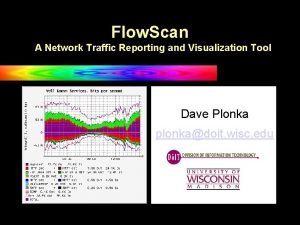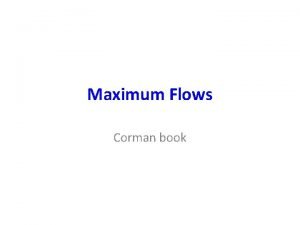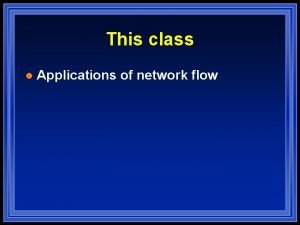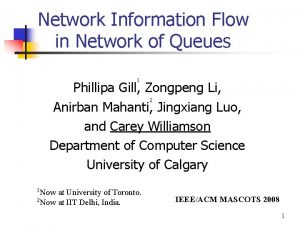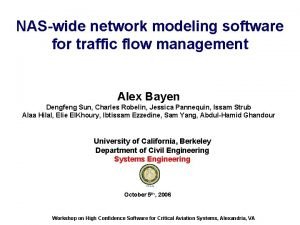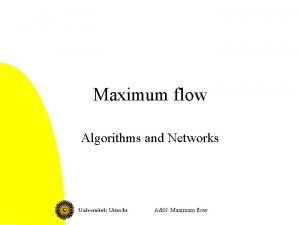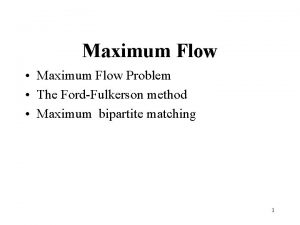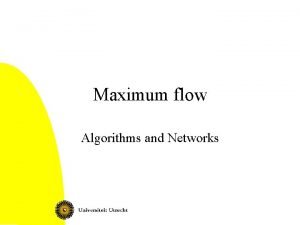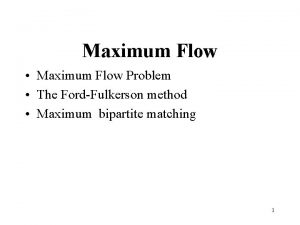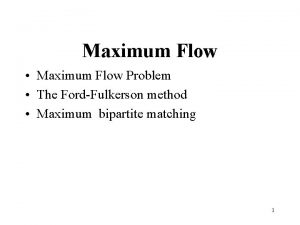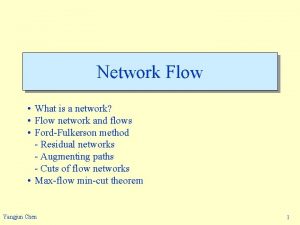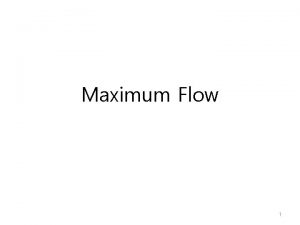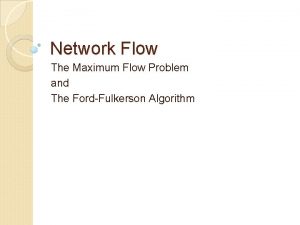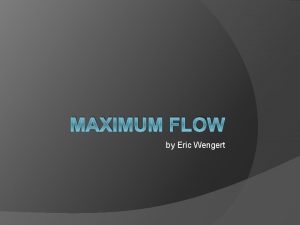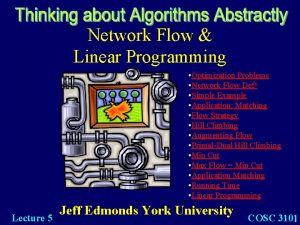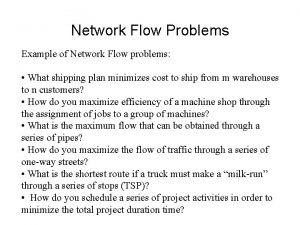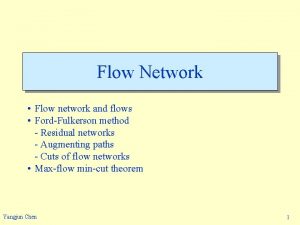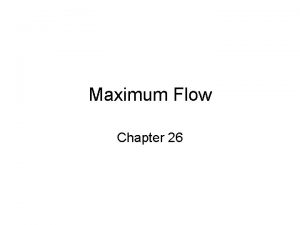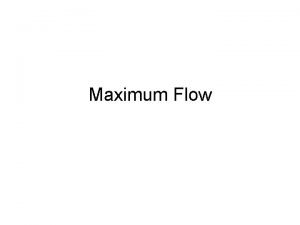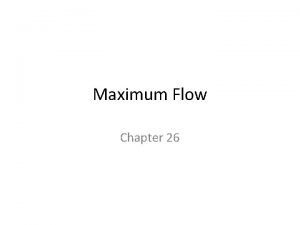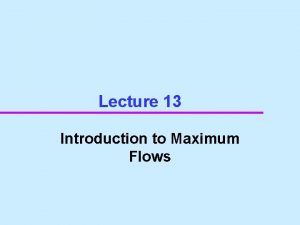Maximum Flow n Maximum Flow A flow network





























- Slides: 29

Maximum Flow

n Maximum Flow A flow network G=(V, E) is a DIRECTED graph where each has a nonnegative capacity u p 2.

n Maximum-flow problem Given a flow network G with source s and sink t, we wish to find a flow of maximum value from s to t 11 12 v 3 20 16 15 1 s 4 9 7 4 13 8 v 2 14 v 4 t 7 4 4 11 p 3.

n positive net flow entering a vertex v: Networks with multiple source and sinks: s 1 s 2 t 1 s 3 t 2 s 4 t 3 s 5 s’ s 2 t 1 s 3 t 2 s 4 t 3 t’ s 5 p 4.

n Ford-Fulkerson method n Residual networks p 5.

Flow network (a) 12/12 v 1 11/16 s 1/4 4/9 v 3 15/20 7/7 8/13 v 2 11/14 t 4/4 v 4 Residual network (b) v 1 5 11 1 5 s 12 v 3 4 3 8 v 2 5 3 11 7 5 15 t 4 v 4

Flow network (c) 12/12 v 1 11/16 s 1/4 9 v 3 19/20 7/7 12/13 v 2 11/14 t 4/4 v 4 Residual network (d) v 1 5 11 1 1 s 12 9 3 12 v 2 3 11 v 3 7 1 19 t 4 v 4

n Lemma 1 Pf: p 8.

p 9.

n Augmenting paths: Given a flow network G=(V, E) and a flow f an augmenting path p is a simple path from s to t in the residual network Gf p 10.

n Lemma 2: n Corollary 3: p 11.

n Cuts of flow networks n n n A cut(S, T) of flow network G=(V, E) is a partition of V into S and T=V-S such that The net flow across the cut(S, T) is defined to be f(S, T). The capacity of the cut(S, T) is c(S, T) Eg: S 16 s v 1 10 4 T 12 9 v 3 7 13 v 2 14 20 v 4 t 4 p 12.

n Lemma 4 Pf: p 13.

n Cor 5 Pf: p 14.

n Thm 6 (Max-flow min-cut theorem) Pf: p 15.

p 16.

n The basic Ford-Fulkerson algorithm M M s t 1 M M p 17.

(a) 16 12 v 1 s 4 v 3 9 20 7 13 v 2 4/16 v 1 s 4 4 v 4 14 4/12 4/9 v 3 4/14 20 7 13 v 2 t v 4 t 4/4

(b) v 1 12 4 s 4 13 s 4/13 v 3 4 4/4 v 2 t 7 5 4 v 4 4 v 1 20 4 10 v 2 4/16 8 8/12 4/9 4/14 v 3 4/20 7 v 4 t 4/4

(c) v 1 12 4 s 9 4 8/12 9 v 3 4/14 8/20 7 4/13 v 2 t v 4 4 v 1 4 4 10 v 2 16 7 5 4 s v 3 8 4 4 8/16 4 v 4 t 4/4

(d) 4 v 1 8 8 8 s 9 4 s 4 8/12 9 v 3 11/14 15/20 7/7 11/13 v 2 t v 4 4 v 1 8 4 10 v 2 12 7 9 4 8/16 v 3 v 4 t 4/4

(e) 4 v 1 8 8 8 s 11 4 s 4 12/12 9 v 3 11/14 19/20 7/7 11/13 v 2 t v 4 11 v 1 15 4 3 v 2 5 7 9 2 12/16 v 3 v 4 t 4/4 p 22.

(f) v 1 4 12 v 3 12 s 9 4 11 2 v 2 3 11 7 1 19 t 4 v 4

n Edmonds-Karp algorithm n Implement the computation of the augmenting path p with a breadth-first search. n That is the augmenting path is a shortest path from s to t in the residual network, where each edge has unit distance. p 24.

n Lemma 7 Pf: (*) p 25.

p 26.

n Thm 8 Pf: p 27.

p 28.

There at most O(E) pairs of vertices that can have an edge between them in a residual graph, the total number of critical edges during the entire execution of the Edmonds-Karp algorithm is O(VE). Each augmenting path has at least one critical edge, and hence theorem follows. Each iteration of Ford-Fulkerson can be implemented in O(E) time, when the augmenting path is found by BFS. Total running time of the Edmonds-Karp algorithm is O(VE 2). Asymptotically fastest to date for maximum-flow:
 Absolute maximum and minimum
Absolute maximum and minimum Maximum likelihood vs maximum parsimony
Maximum likelihood vs maximum parsimony Maximum likelihood vs maximum parsimony
Maximum likelihood vs maximum parsimony Baseball elimination problem
Baseball elimination problem A switched wan is normally implemented as a
A switched wan is normally implemented as a Types of network topology
Types of network topology Features of peer to peer network and client server network
Features of peer to peer network and client server network Network systems design using network processors
Network systems design using network processors Network centric computing and network centric content
Network centric computing and network centric content Packet switching disadvantages
Packet switching disadvantages Phasets
Phasets Network traffic flow diagram
Network traffic flow diagram Flow network
Flow network Properties of flow network
Properties of flow network What is flow control in computer network
What is flow control in computer network Network flow matrix
Network flow matrix Network flow applications
Network flow applications Network information flow
Network information flow Traffic modeling software
Traffic modeling software Absorption atelectasis
Absorption atelectasis Venturi mask flow rate
Venturi mask flow rate Different types of oxygen masks nursing
Different types of oxygen masks nursing Laminar flow and turbulent flow definition
Laminar flow and turbulent flow definition Internal flow vs external flow
Internal flow vs external flow Energy naturally flows from warmer matter to cooler matter.
Energy naturally flows from warmer matter to cooler matter. Flow of energy vs flow of matter
Flow of energy vs flow of matter Transform flow and transaction flow
Transform flow and transaction flow Data flow structure
Data flow structure Irrotational flow means *
Irrotational flow means * Internal vs external flow
Internal vs external flow


